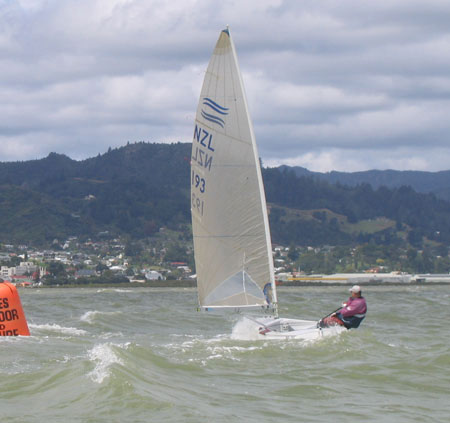Things I Would Do Differently
It is not till you start sailing the boat that you find all the little things that are not just quite right.

While designing the boat considerable time was spent in cockpit water control methods. The cockpit floor is maximum height
at stations 3 and 4. This gives a nice slope to the floor, draining water forward to the centre of the boat where a small Anderson self bailer
gets rid of it (for maximum self bailing capacity the second bailer is the biggest Anderson self bailer I could find). Normally sail on
windy, rough days with just the small self bailer open. Copes very nicely. Aft of station 3 the floor levels off to meet the floor height
restriction at station 2.
Inserted cockpit drain tubes that exit at very lowest point of the transom. On paper the angle is
steep enough to prevent water flowing back into the cockpit. In reality the opposite is true and on very light days a steady trickle of
water enters the cockpit. Wouldn't bother with cockpit drain tubes in future. The only time they will be seriously useful is when one of
those half capsizes scoops up a cockpit full of water. Had a rethink on that score. Found that I have had a tendency to sit to far back in
the boat when in a light breeze. By shifting a bit further forward the transom lifts out of the water, nothing drains back into the
cockpit PLUS get an increase in boat speed!
To drain the forward compartment a small one way flutter valve was used. This has
proved to be totally useless. Will replace with a bigger flap type arrangement.
Using blocks as the position adjustment in the bottom mast step makes it easier to change mast setups on shore (no need to
count turns or worry if you are turning the screw the right or wrong way) it is much more difficult to make those mast
adjustments out on the water. Long way in to reach the blocks especially on a rough day. Currently
don't bother to alter
the bottom mast step position while on the water, just top mast ring and centreboard position to cope with changing
sailing conditions.
In future I would go back to a screw type arrangement but would either extend the screw
back out into the cockpit or set it up with a
beveled gear and a vertical shaft to the deck. On the deck or in the
cockpit would have a small wheel to turn the crew and make bottom mast step adjustments. Could include a dial
indicator to get accurate fixes on where the bottom mast step location is.
The two centreboard positioning block rebated into the centrecase capping are held in place by 5mm bolts tapped into the
plastic. Slots in the alloy allows sideways movement to centralise the centreboard in a vertical position.
Unfortunately there is such a sideways force on the centreboard that the 5mm locater bolts slide in the slots. Between
races need to get the screwdriver out and reset to blocks positions. Would be better of to have the locator bolts in the
horizontal plane (i.e.. come in from the sides rather than from the top). Would only require welding tapped bosses onto the
alloy angle brackets plus a lock nut to keep them from coming loose.
Then of course you will find all the little things that are not right. Main sheet cleats to low in the cockpit, hiking
straps not in the right position, centereboard control sheet turning blocks too far forward on the gunnels, using too
small a diameter bungy cords on the centreboard, hiking pad tie down hooks to close to the cockpit floor (just high enough
to snag sailing boots when going about or gybing), top rudder gudgeon pin cut to short so that when the rudder pin is
removed the minimum weight rudder floats off the top pin.
All easily fixable, just annoying.
To take advantage of the new reduced minimum weight restriction, we bought the Finn into the shed for rebuild Number 2. On The Diet - Part One

